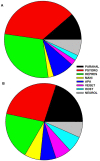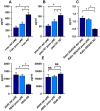Cerebrospinal fluid biomarkers in psychiatric autoimmune encephalitis: a retrospective cohort study
- PMID: 37363167
- PMCID: PMC10287966
- DOI: 10.3389/fpsyt.2023.1165153
Cerebrospinal fluid biomarkers in psychiatric autoimmune encephalitis: a retrospective cohort study
Abstract
Background: Psychiatric autoimmune encephalitis (pAE) is a growing field of interest in diagnosis and therapy in psychiatric hospitals and institutions. This study investigates the relevant extent to which there are potential biomarkers in cerebrospinal fluid (CSF) that can differentiate against a cohort with neurodegenerative disease.
Methods: We included in this study a total of 27 patients with possible and definite psychiatric autoimmune encephalitis and compared with a cohort with CSF-based AD (n = 27) different biomarkers in CSF such as lactate, cell count, % lymphocytes, % monocytes, total protein content, albumin, immunoglobulins G (IgG), M (IgM) and A (IgA), CSF/serum albumin ratio, CSF/serum IgG ratio, CSF/serum IgA ratio, intrathecal IgG synthesis, blood-brain barrier disruption, specific antibody synthesis for measles, rubella, herpes simplex virus, varicella zoster virus, Ebstein-Barr virus and cytomegalovirus, total tau protein (t-tau), phosphorylated tau protein 181 (p-tau181), amyloid beta 42 (Aß42), amyloid beta 40 (Aß40) and the amyloid beta 42/ amyloid beta 40 (Aß42/40) ratio.
Results: The p-tau 181 was elevated above cut-off values in both possible pAE and AD. However, in definitive pAE, p-tau181 levels were not elevated. When elevated p-tau181 levels in possible AE were compared with those in AD, we found relevant differences, such as a relative increase in p-tau181 in AD patients. Elevated p-tau181 levels were detected in possible psychiatric AEs with IgLON5, glycine, recoverin, titin, and nonspecific neuropil antibodies in serum and IgLON5, titin, Yo, and nonspecific neuropil autoantibodies in CSF. In addition, we detected elevated levels of p-tau181 and IgLON5 autoantibodies in serum and CSF, and Yo autoantibodies in CSF in patients with definitive pAE. Interestingly, we observed a higher CSF/serum IgM ratio in possible and definitive pAE than in AD patients.
Conclusion: Our results suggest that neuroaxonal brain damage may occur in specific psychiatric AEs associated with IgLON5, glycine, recoverin, and titin autoantibodies. Further research should focus on the CSF/serum IgM ratio as an early marker of autoantibody production in pAE compared to AD as a potential biomarker for differential diagnosis.
Keywords: Alzheimer’s disease; autoimmune encephalitis; biomarker; cerebrospinal fluid; neurodegeneration markers.
Copyright © 2023 Hansen, Juhl, Grenzer, Teegen, Wiltfang and Fitzner.
Conflict of interest statement
The authors declare that the research was conducted in the absence of any commercial or financial relationships that could be construed as a potential conflict of interest.
Figures


References
-
- Endres D, Lüngen E, Hasan A, Kluge M, Fröhlich S, Lewerenz J, et al. . Clinical manifestations and immunomodulatory treatment experiences in psychiatric patients with suspected autoimmune encephalitis: a case series of 91 patients from Germany. Mol Psychiatry. (2022) 27:1479–89. doi: 10.1038/s41380-021-01396-4, PMID: - DOI - PMC - PubMed
-
- Hansen N, Lüdecke D, Maier HB, Steiner J, Neyazi A. Psychiatrische Autoimmunenzephalitis -Diagnose und therapeutische Ansätze. PSYCHupdate2. (2023) 17:13–28. doi: 10.1055/a-1400-8393 - DOI
-
- Constantinescu R, Krýsl D, Bergquist F, Andrén K, Malmeström C, Asztély F, et al. . Cerebrospinal fluid markers of neuronal and glial cell damage to monitor disease activity and predict long-term outcome in patients with autoimmune encephalitis. Eur J Neurol. (2016) 23:796–806. doi: 10.1111/ene.12942, PMID: - DOI - PubMed
LinkOut - more resources
Full Text Sources
Miscellaneous

